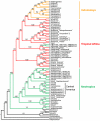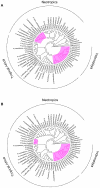The use of phylogeny to interpret cross-cultural patterns in plant use and guide medicinal plant discovery: an example from Pterocarpus (Leguminosae)
- PMID: 21789247
- PMCID: PMC3138776
- DOI: 10.1371/journal.pone.0022275
The use of phylogeny to interpret cross-cultural patterns in plant use and guide medicinal plant discovery: an example from Pterocarpus (Leguminosae)
Abstract
Background: The study of traditional knowledge of medicinal plants has led to discoveries that have helped combat diseases and improve healthcare. However, the development of quantitative measures that can assist our quest for new medicinal plants has not greatly advanced in recent years. Phylogenetic tools have entered many scientific fields in the last two decades to provide explanatory power, but have been overlooked in ethnomedicinal studies. Several studies show that medicinal properties are not randomly distributed in plant phylogenies, suggesting that phylogeny shapes ethnobotanical use. Nevertheless, empirical studies that explicitly combine ethnobotanical and phylogenetic information are scarce.
Methodology/principal findings: In this study, we borrowed tools from community ecology phylogenetics to quantify significance of phylogenetic signal in medicinal properties in plants and identify nodes on phylogenies with high bioscreening potential. To do this, we produced an ethnomedicinal review from extensive literature research and a multi-locus phylogenetic hypothesis for the pantropical genus Pterocarpus (Leguminosae: Papilionoideae). We demonstrate that species used to treat a certain conditions, such as malaria, are significantly phylogenetically clumped and we highlight nodes in the phylogeny that are significantly overabundant in species used to treat certain conditions. These cross-cultural patterns in ethnomedicinal usage in Pterocarpus are interpreted in the light of phylogenetic relationships.
Conclusions/significance: This study provides techniques that enable the application of phylogenies in bioscreening, but also sheds light on the processes that shape cross-cultural ethnomedicinal patterns. This community phylogenetic approach demonstrates that similar ethnobotanical uses can arise in parallel in different areas where related plants are available. With a vast amount of ethnomedicinal and phylogenetic information available, we predict that this field, after further refinement of the techniques, will expand into similar research areas, such as pest management or the search for bioactive plant-based compounds.
Conflict of interest statement
Figures






Similar articles
-
Phylogenies reveal predictive power of traditional medicine in bioprospecting.Proc Natl Acad Sci U S A. 2012 Sep 25;109(39):15835-40. doi: 10.1073/pnas.1202242109. Epub 2012 Sep 10. Proc Natl Acad Sci U S A. 2012. PMID: 22984175 Free PMC article.
-
Ethnobotany of medicinal plants used in Antakya: A multicultural district in Hatay Province of Turkey.J Ethnopharmacol. 2015 Nov 4;174:118-52. doi: 10.1016/j.jep.2015.07.042. Epub 2015 Jul 31. J Ethnopharmacol. 2015. PMID: 26239155
-
Phylogenetic exploration of commonly used medicinal plants in South Africa.Mol Ecol Resour. 2015 Mar;15(2):405-13. doi: 10.1111/1755-0998.12310. Epub 2014 Aug 12. Mol Ecol Resour. 2015. PMID: 25066923
-
A cross-cultural analysis of Jammu, Kashmir and Ladakh (India) medicinal plant use.J Ethnopharmacol. 2014 Sep 11;155(2):925-86. doi: 10.1016/j.jep.2014.06.029. Epub 2014 Jun 19. J Ethnopharmacol. 2014. PMID: 24952280 Review.
-
Medicinal plants for gastrointestinal diseases among the Kuki-Chin ethnolinguistic groups across Bangladesh, India, and Myanmar: A comparative and network analysis study.J Ethnopharmacol. 2020 Apr 6;251:112415. doi: 10.1016/j.jep.2019.112415. Epub 2020 Jan 7. J Ethnopharmacol. 2020. PMID: 31917280 Review.
Cited by
-
Biotechnological Advances in Pharmacognosy and In Vitro Manipulation of Pterocarpus marsupium Roxb.Plants (Basel). 2022 Jan 18;11(3):247. doi: 10.3390/plants11030247. Plants (Basel). 2022. PMID: 35161227 Free PMC article. Review.
-
Diversity and evolution of leaflet anatomical characters in the Pterocarpus clade (Fabaceae: Papilionoideae).J Plant Res. 2023 Jul;136(4):453-481. doi: 10.1007/s10265-023-01450-y. Epub 2023 Apr 8. J Plant Res. 2023. PMID: 37029839
-
Phylogenies reveal predictive power of traditional medicine in bioprospecting.Proc Natl Acad Sci U S A. 2012 Sep 25;109(39):15835-40. doi: 10.1073/pnas.1202242109. Epub 2012 Sep 10. Proc Natl Acad Sci U S A. 2012. PMID: 22984175 Free PMC article.
-
21st century natural product research and drug development and traditional medicines.Nat Prod Rep. 2013 Apr;30(4):584-92. doi: 10.1039/c3np20120a. Nat Prod Rep. 2013. PMID: 23450245 Free PMC article. Review.
-
Important Medicinal and Food Taxa (Orders and Families) in Kenya, Based on Three Quantitative Approaches.Plants (Basel). 2023 Mar 2;12(5):1145. doi: 10.3390/plants12051145. Plants (Basel). 2023. PMID: 36904005 Free PMC article. Review.
References
-
- Farnsworth NR, Soejarto DD. Global importance of medicinal plants. In: Akerele O, Heywood V, Synge H, editors. The Conservation of Medicinal Plants. Cambridge: Cambridge University Press; 1991. pp. 25–52.
-
- Clarkson C, Maharaj VJ, Crouch NR, Grace OM, Pillay P, et al. In vitro antiplasmodial activity of medicinal plants native to or naturalised in South Africa. Journal of Ethnopharmacology. 2004;92:177–191. - PubMed
-
- Wright CI, Van-Buren L, Kroner CI, Koning MMG. Herbal medicines as diuretics: A review of the scientific evidence. Journal of Ethnopharmacology. 2007;114:1–31. - PubMed
-
- Amiguet VT, Arnason JT, Maquin P, Cal V, Sanchez-Vindas P, et al. A regression analysis of q‘eqchi’ Maya medicinal plants from southern Belize. Economic Botany. 2006;60:24–38.
Publication types
MeSH terms
LinkOut - more resources
Full Text Sources
Other Literature Sources
Molecular Biology Databases

